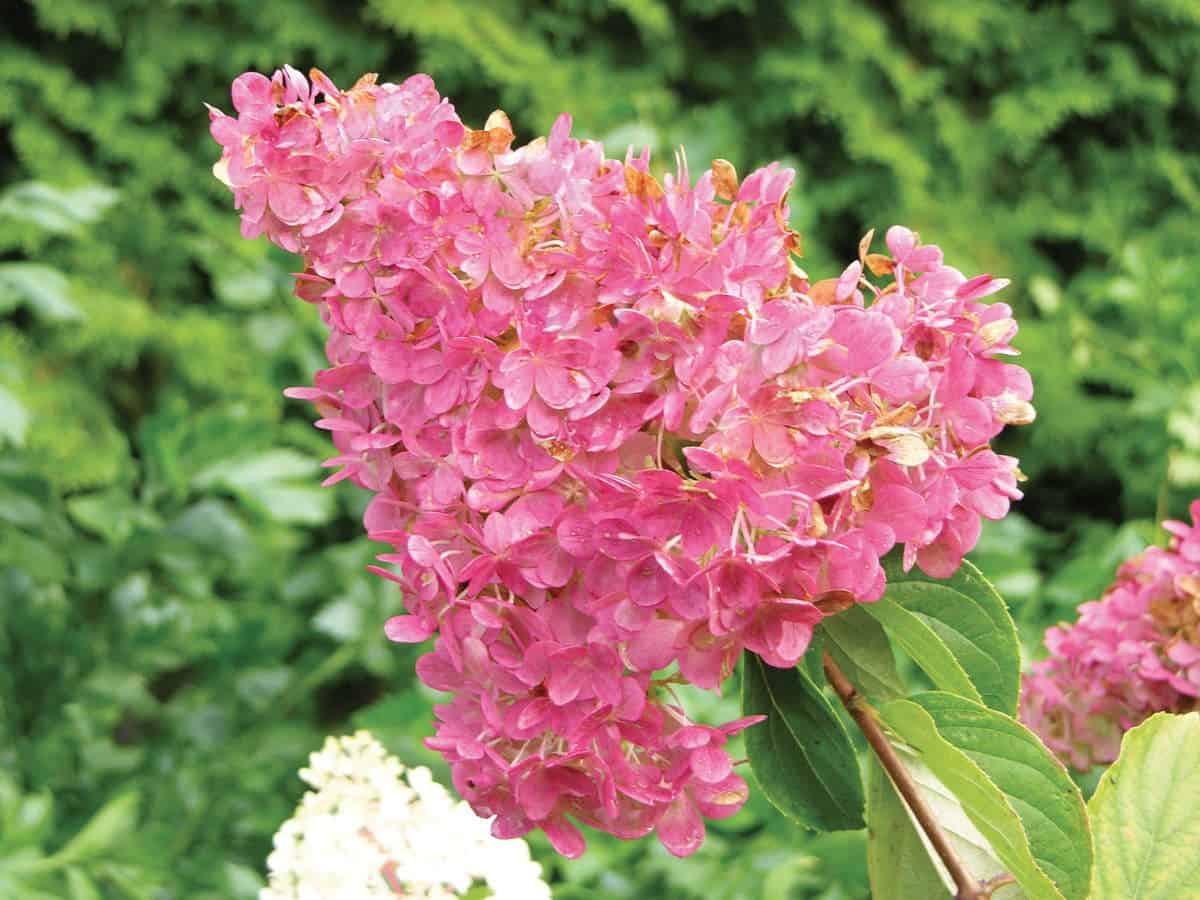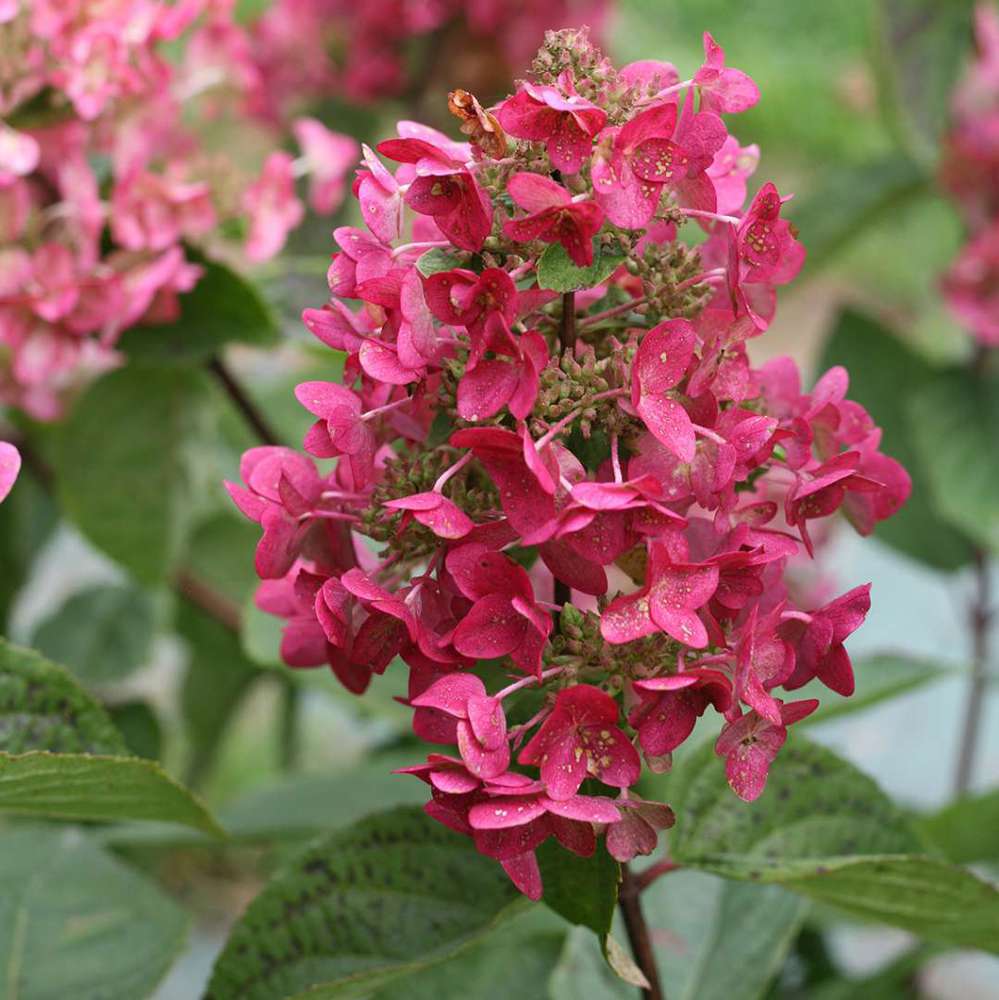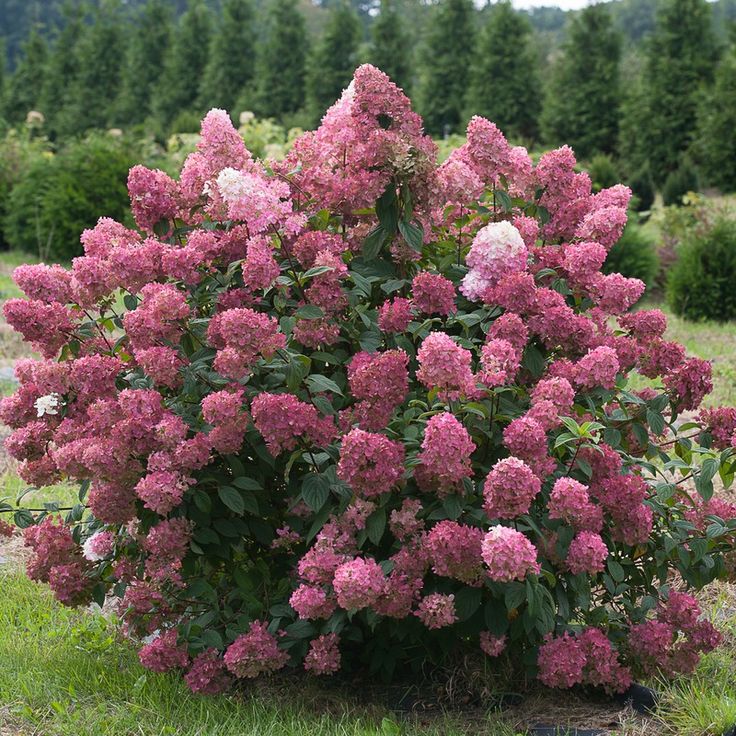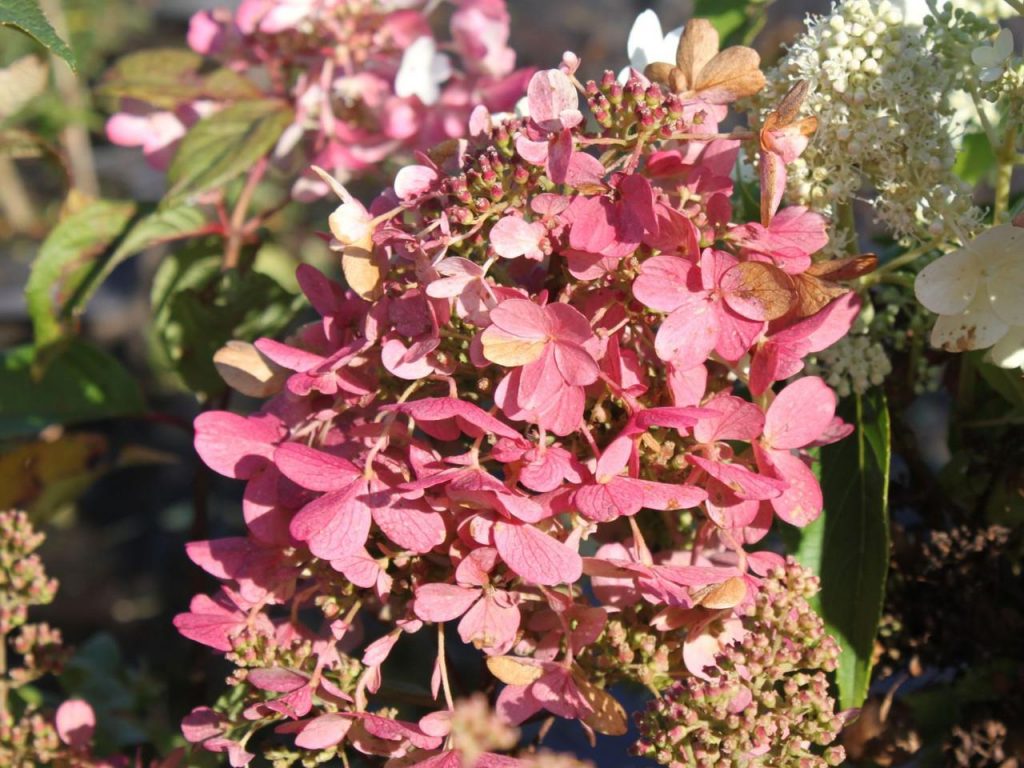Hydrangea paniculata Mega Mindy - burgundy splendor in the garden
Large-flowered panicle hydrangea Mega Mindy is one of the brightest shrubs, which is distinguished by lush, long flowering and good winter hardiness, therefore it is suitable for cultivation in all regions of our country. Consider the description of the variety, the rules for planting and caring for it.

Panicle hydrangea mega mindy
Characteristic
This variety of panicle hydrangea is prized for its long flowering, which lasts from the first half of July to the end of October.
The botanical name is hydrangea paniculata Mega Mindy.
The shrub is lush and tall, with numerous, brown-red, erect, rigid stems up to 1.2-1.7 m in length. The root system is superficial, well-branched.
The flowers are huge, sterile, formed on the tops of the shoots of the current year, collected in racemose panicles with a circumference of 30 cm.
Initially, the flowers are snow-white, later turn pink, and towards autumn they acquire a rich crimson tone.
Dry buds can be a home decor decoration throughout the winter.
The leaves are long, ovate, rough, oppositely arranged, emerald in color, turn yellow in early autumn;
Landing rules
Subject to some subtleties and secrets, the success of growing mega mindy hydrangea will be guaranteed.
You can buy seedlings in one of the specialized nurseries. It is better to choose at the age of 2-3 years - they already have a well-developed root system.
They are usually sold in containers or with an earthen ball. In the ground, the roots are protected from drying out.
To get a strong bush that will delight you with its beauty in the future, you need to pay attention to its appearance.
- In healthy bushes, the crown consists of several stems, densely covered with leaves.
- Shoots and foliage of a rich color, without yellowness, black spots, blotches and breaks.
If you buy a plant with open roots, you need to prune them a little, soak them in a clay solution for several hours and plant them right away. If this is not done, the bushes will dry out quickly.
Timing
The best time to plant seedlings is spring, from late March to mid-April.
The main thing is that the soil warms up to 10-12 ° C and the positive street temperature stabilizes.
In the southern regions, gardeners plant the plant in early autumn - in the first half of September. So the shrub has time to adapt, take root and prepare for the upcoming wintering.
Preparatory activities
This ornamental crop prefers to grow on light, well-drained soil with a high content of organic and mineral substances. Soil suitable for both low and high acidity. In the first case, the inflorescences will be pale pink, in the second - a rich crimson color.

Hydrangea mega mindy paniculata
Grows well on sandy and loamy soil. When planting on sandy loam, you will need to add a couple of buckets of clay per 1 m². If the cultivation is planned on loam, add 20 kg of sand or vermiculite.
Prefers sunny places with little shade at lunchtime. Choose an area that is sheltered from the winds.
Do not plant under trees, near other bushes, which can create competition for moisture and nutrients. It is also not recommended to plant it under the walls of a house or farm building. Water flowing from the roofs will fall on the crown and cause it to rot. In addition, such a structure will provide a constant shade, which will negatively affect the quality of flowering.
Technology
Before harvesting planting holes, the site is freed from debris, last year's vegetation, dug up and leveled.
- Pits are dug a little larger than the root system. Approximate parameters - 40x50 cm.
- A couple of handfuls of drainage (crushed stone, pebbles or screenings) are placed on the bottom.
- Then it is filled in half with a nutrient composition of humus, peat, mixed in equal amounts with the addition of 50 g of mineral fertilizer.
- The bushes are planted together with an earthen clod so as not to damage the roots. They are carefully spread in different directions. Deepen so that the root collar is 2-3 cm in the ground, but not deeper, otherwise the seedling will quickly rot and die.
- They fall asleep to the top with soil mixture, trample, watered. To prevent the roots from drying out, mulch with peat or compost.
Care
Watering
It is a moisture-loving crop that does not tolerate drought. Therefore, it must be watered often and abundantly.

Hydrangea paniculata mega mindy
- In spring and summer - every three days, provided there is no rain.
- In autumn, the need for moisture is determined by the condition of the soil - it is moistened if it has dried out to a depth of 5-6 cm.
Use warm and settled water to prevent hypothermia of the roots. Consumption for one young bush is 10 liters, for an adult plant - 20 liters.
After watering, surface loosening is carried out to avoid the formation of a crust. They also weed the soil between the rows, remove weeds, mulch the near-trunk zone with peat or last year's manure.
Top dressing
The first two years, the seedlings do not feed, because the nutrients laid down during planting are enough for full growth and flowering.
After this time, the following power scheme is applied:
- from the beginning of spring to mid-summer, the bushes are watered with liquid nitrogen preparations with an interval of 14 days;
- additionally, in the first half of March, the near-stem zone is sprinkled with any long-acting top dressing, for example, Pocon;
- to strengthen the root system and stems, once a month from the beginning of the growing season until late autumn, the bush is shed with a weak solution of potassium permanganate (0.2 g of the substance is dissolved in a bucket of water);
- a couple of weeks before budding, Fertik's granular fertilizer is applied.
At the end of August, food is stopped, because the plant enters a dormant phase.
Pruning
This procedure is carried out in early spring during the swelling of the vegetative buds. Weakened, frozen, broken off and shrunken parts are cut out.
For those who want to get a compact shrub in the form of a tree, it is necessary to shorten the cuttings by 1/3 of the length over several years.
In the fall, for successful wintering, the branches of the current year are pruned to 4 eyes. For old hydrangeas, a rejuvenating haircut is carried out - all the stems are cut at the root. The next year, the bush will release new shoots, on which there will be flowering in the future.
In young seedlings in the first year of life, it is necessary to cut off the buds, since they inhibit the growth of the root system and green mass.
All manipulations are carried out using a sharp and disinfected secateurs. After cutting, the twigs are irrigated with copper sulfate - this will help prevent infection with various sores.
Leaving the flowering phase
To achieve the longest possible flowering, the bushes are watered abundantly, but without fanaticism - with an excess of moisture, they will quickly rot.

Mega mindy hydrangea paniculata
Exclude all dressings that inhibit the formation and blooming of buds. Faded inflorescences are periodically removed to accelerate the development of new ones.
Post-flowering care
The plant requires minimal care - watered once a month, excluding all fertilizing. Unviable parts and dried flowers are cut out.
Preparing for winter
Young seedlings with low frost resistance need to be insulated for three years. A week before frost, the trunk circle is mulched with peat, compost or last year's manure. The remaining strong shoots after the autumn pruning are neatly tied, bent to the ground, fixed with staples, sprinkled with a thick layer of fallen leaves or sawdust.
Panicle hydrangea stays under such insulation until spring. As soon as the sun warms up and the last cold weather passes, the covering material is removed.
Reproduction methods
Cuttings
Harvesting of planting material is done in spring or summer. On lignified stems, shoots of the current year 15-20 cm long are chosen. It is important that they have leaves with buds on them. They are carefully separated, in the lower part they are freed from the leaves. For fast rooting, they are dipped for a couple of hours in Heteroauxin or Kornevin.
After this time, they are planted in a wet mixture of peat and sand to a depth of 3-4 cm. Greenhouse conditions are created - covered with a transparent film or half of a plastic bottle. Every day, planting is aired for half an hour, as the substrate dries, it is moistened.
After about 3-4 weeks, leaves should appear on the cuttings, which indicates successful rooting. The shelter is removed, the seedlings are placed in a warm place with diffused light. They grow for another month so that they are well overgrown with roots, after which they are planted in the garden.
By dividing the bush
This method is advisable for old bushes that have stopped growing and stopped blooming. Reproduction by dividing the root will restore their decorative effect and development.

Hydrangea mega mindy description photo
The shrub is watered abundantly, after an hour it is dug in and carefully removed from the soil. Washed from the ground. Cut into pieces with a garden shovel. For successful rooting, each seedling must have several roots, 1-2 shoots with live leaves and buds.
To avoid infection, all cut off places are irrigated with a solution of copper sulfate. After drying, the cuttings are planted in the garden.
Stem layering
This procedure begins in the middle of autumn. On an adult plant, choose the most flexible lignified lash, which is close to the ground. Remove the leaves on it. Nearby, a trench 5-6 cm deep is dug out, a twig is lowered into it in a horizontal position, sprinkled with a mixture of peat, sand and humus (1: 1: 1), watered with warm water.
10 days before the upcoming frost, cover with a thick layer of fallen leaves, peat or compost to protect it from freezing in winter.
In the spring, when the snow melts and the above-zero temperature stabilizes, the stem is dug up, cut off from the mother bush. Divided into several segments with roots, seated in a permanent habitat in a flower garden.
Diseases and pests
The panicle hydrangea Mega Mindy has several sores and parasites that appear when the rules of agricultural technology are violated:

Hydrangea paniculata mega mindy
- Chlorosis. It occurs when there is a lack of iron in the soil. The leaves turn pale, reddish veins are clearly visible on the surface. You can correct the situation if you feed the shrub with chelating drugs.
- Peronosporosis. Leaves are covered with yellow, oily spots that darken over time. The affected areas die off. Treatment with a solution of 15 g of copper sulfate, 150 g of liquid soap per 10 liters of water is required.
- Powdery mildew.A whitish bloom in the form of flour on foliage and stems, later the infected parts turn black and crumble. They are treated with Fitosporin, Topaz or Skor.
- Of the pests, spider mites, aphids, and nematodes are annoying. Infected areas turn yellow, curl and dry out. Commander, Tanrek or Akarin will help to destroy parasites.
For prevention, you must follow all the rules for care, buy healthy and strong seedlings, avoid thickening when planting them, and also keep the flower garden clean.
Application in garden design
Gardeners use this flowering crop in several compositions:
- planted singly in the center of the garden, flower beds, near gazebos, terraces;
- combine with other varieties of hydrangeas, creating a variegated hedge of various shades;
- planted surrounded by perennial ornamental deciduous plants of different heights - junipers, fir, hosts.
Testimonials
Numerous positive reviews have made mega mindy hydrangeas very popular and in demand:
- not afraid of frost, easily tolerates a haircut and, with good care, practically does not get sick - thanks to these qualities, even a novice florist can grow him;
- successful reproduction in several ways allows you to get many new specimens for further gardening of the garden;
- it takes root well with other vegetation, therefore it is suitable for use in various compositions and decorations.

